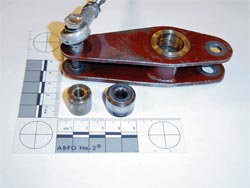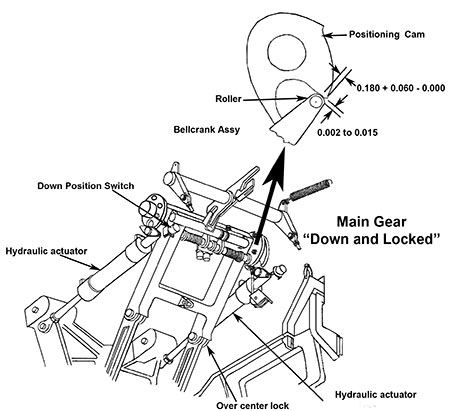Landing Gear Collapse and Runway Excursion
Northern Dene Airways Ltd. (Norcanair)
Fairchild SA-227-AC Metro III C-FIPW
La Ronge, Saskatchewan
The Transportation Safety Board of Canada (TSB) investigated this occurrence for the purpose of advancing transportation safety. It is not the function of the Board to assign fault or determine civil or criminal liability. This report is not created for use in the context of legal, disciplinary or other proceedings. See Ownership and use of content. Masculine pronouns and position titles may be used to signify all genders to comply with the Canadian Transportation Accident Investigation and Safety Board Act (S.C. 1989, c. 3).
Summary
A Northern Dene Airways Ltd. Metro III (registration C-FIPW, serial number AC524), operating as Norcanair Flight KA1051, departed Stony Rapids, Saskatchewan, with two crew members and nine passengers on a day, visual flight rules flight to La Ronge, Saskatchewan. On arrival in La Ronge, at approximately 1410 central standard time, the crew completed the approach and landing checklists and confirmed the gear-down indication. The aircraft was landed in a crosswind on Runway 18 and touched down firmly, approximately 1000 feet from the threshold.
On touchdown, the left wing dropped and the propeller made contact with the runway. The aircraft veered to the left side of the runway, despite full rudder and aileron deflection. The crew applied maximum right braking and shut down both engines. The aircraft departed the runway and travelled approximately 200 feet through the infield before the nose and right main gear were torn rearwards; the left gear collapsed into the wheel well. The aircraft slid on its belly before coming to rest approximately 300 feet off the side of the runway. Three of the passengers suffered minor injuries from the sudden stop associated with the final collapsing of the landing gear; the other passengers and the pilots were not injured.
Factual information
After the occurrence, and prior to shutting down the electrics, it was noted that the left main landing gear still indicated down and locked, while the nose and right main gear indicated unsafe. While the captain secured the aircraft, the passengers evacuated the aircraft through the two right overwing exits. Once out of the aircraft, the passengers were attended to by emergency response personnel.
The weather at La Ronge at the time of the occurrence, approximately 1410 central standard time,Footnote 1 was as follows: visibility 15 statute miles; clear skies; temperature 16°C; and wind 250°M at 17 knots, gusting to 24 knots.
A puff of smoke came from the tires as the aircraft touched down. An examination of the aircraft after the occurrence revealed that the outboard tire on the left landing gear had a bald spot, which had worn down to the tire cord. The bald spot was on the outboard edge of the tire tread at a slight diagonal to the tread pattern. The tire had been installed new approximately 63 flight hours prior to the occurrence.
The landing gear is designed with a three-piece drag brace attached to the gear struts and the aircraft wheel wells. Each drag brace hinges at both ends and in the centre to allow it to fold up into the wheel well during retraction. To ensure that the gear will remain down and locked during ground operations, the drag brace centre hinge travels slightly upward, to a locking overcentre travel limit stop, opposite to its normal folding movement. Because the drag brace hinges at three points, devices are needed to hold it against its overcentre stops. Two of these devices are positioning cams that bolt to the inboard and outboard ends of each upper drag brace. Each cam has a concave cutout to receive the roller of a bellcrank and roller assembly, which is mounted to the aircraft wheel well. When the landing gear is fully extended, the drag brace is forced into its overcentre position by the bellcrank roller resting against the heel of the positioning cam. With the roller in this position, the gear is said to be in the "down and locked" position.
An inboard and outboard hydraulic actuator is mounted on each of the main landing gear assemblies to assist extension and retraction. To prevent the landing gear from collapsing, the position of the bellcrank roller relative to the cam cutout is critical and is determined by adjusting the length of the landing gear actuator rods.
The bellcrank assembly roller is held in its locked position by hydraulic pressure in the fully extended actuating cylinder and by spring tension. During normal extension of the main gear, only the outboard cylinders are pressurized with the inboard bellcrank being held by spring tension only. Two down-indication micro switches (one at each actuator bellcrank) provide a gear-down indication in the cockpit when both micro switches are activated.
The nose and right landing gear assemblies were severely damaged during impact. The actuators were pulled away from the down-indication micro switches, causing the unsafe gear indications after the occurrence. The left gear was folded into the wheel well, with both bellcrank rollers being driven beyond the positioning cams cutouts. The actuators were still in the down-extended position, thereby making contact with the down-indication micro switches and resulting in the left gear green, down-and-locked indication.
A crane was used to place the aircraft on a flat bed truck. The left landing gear was then repositioned and a rigging check was carried out on the bellcrank roller in relation to its location on the heel of the positioning cam. The Metro III maintenance manual stipulates that the measurement from the centre of the roller to the edge of the cam must be 0.180 inches, tolerance range +0.060, -0.000 (see Appendix A). This measurement on the inboard bellcrank roller was approximately 0.0625 inches; however, the edge or lip of the cam was worn or damaged slightly, which may have reduced this measurement. This indicates that the inboard bellcrank-to-cam assembly was out of adjustment.
The outboard bellcrank roller could not be measured because the roller was found to be undersized (0.625-inch diameter instead of the designed 0.750-inch diameter). The smaller diameter roller reduced the required rigging allowances for the bellcrank-to-cam assembly in the down-and-locked position. Marks or gouges were found on the roller where the lip of the positioning cam had been making contact.
A review of the aircraft technical records showed that the left gear outboard bellcrank roller had been replaced with a part number 5453032-1 roller on 09 August 2004, approximately 209 flight hours prior to the accident. The manufacturer's parts manual shows part number 5453032-1 to be that of a landing gear uplock roller for this type of aircraft's vice bellcrank roller; it is made of a solid bushing material (see Photo 1). The proper bellcrank roller is listed as a part number YCRS-12 bearing, comprised of an outer race running around rollers over an inner race. The YCRS-12 bearing roller is larger in diameter than the one installed.
Four aircraft maintenance engineers (AMEs) and one apprentice engineer were hired to conduct maintenance on the company's two Metro III aircraft. These AMEs were based in Saskatoon, Saskatchewan. The maintenance was done under the authority and oversight of a contracted approved maintenance organization (AMO) that was based in Prince Albert, Saskatchewan. Northern Dene Airways Ltd. coordinated the work done on the aircraft with the AMO through its person responsible for maintenance. The AMO was responsible for ensuring that the maintenance done on the aircraft met airworthiness standards.
The AME who replaced the left outboard bellcrank roller on 09 August 2004 was fully trained on the aircraft type. During an inspection of the aircraft, the roller was found to be missing, having broken away from the attachment bolt, which was still in place. This was the first occurrence of a roller breakage on this aircraft that the AME had encountered. The AME, however, was aware of similar roller breakages on Metro 23 aircraft operated by another company. In those incidents, the AME believed that the rollers re-installed on the aircraft were of a solid material type, designed to alleviate the shattering of the rollers due to the heavier landing weight of the Metro 23. When the roller breakage was discovered on 09 August 2004, the AME went to the company stores area and located a solid roller, the same type of roller that the AME believed was used by the other company as a replacement roller on the Metro 23.
The AME installed the roller without cross-checking the roller part number against the manufacturer's parts manual to confirm whether it was the correct part or whether the roller was an approved newly designed part. Once the roller was installed, the AME did not do the required rigging checks to ensure that the bellcrank roller had been positioned properly in relation to its location on the heel of the positioning cam. A parts number cross-check and a rigging check are standard company and industry practices for the type of work that was performed.
Analysis
The roller installed on the outboard landing gear bellcrank was of a smaller diameter than the required part and was designed to be used as an uplock roller vice bellcrank roller. The smaller diameter of the roller reduced the required clearance in relation to the roller's location on the heel of the positioning cam. Repetitive landing loads transmitted through the drag brace were initially absorbed by the roller hitting the lip of the cam, until the lip of the cam was worn away. The wear eventually allowed the roller to move beyond the cam cutout position. Consequently, the drag brace was primarily held in the down-and-locked position by the inboard bellcrank roller and the positioning cam, both of which were out of adjustment and held in position by spring tension only.
The landing in La Ronge was firm, with a crosswind component. The smoke that came from the tires upon touchdown was consistent with the wear pattern observed on the left outboard tire. The side loading placed on the left landing gear during the landing was sufficient to override the spring tension and snap the inboard roller beyond the cam cutout position, allowing the landing gear to collapse.
The AME installed an incorrect roller, believing that it had been re-designed to alleviate roller breakage. The AME did not follow established industry or company practices in checking the part number against the manufacturer's parts manual to ensure that the correct part was being installed. A rigging check was not completed, which likely would have established that the roller was undersized.
Findings as to Causes and Contributing Factors
- An incorrect roller of a smaller diameter and type was installed on the left main landing gear outboard bellcrank assembly, contrary to company and industry practice.
- The smaller diameter roller reduced the required rigging tolerances for the bellcrank-to-cam assembly in the down-and-locked position and allowed the roller to eventually move beyond the cam cutout position, resulting in the collapse of the left landing gear.
- A rigging check was not carried out after the replacement of the bellcrank roller. Such a check should have revealed that neither the inboard nor outboard bellcrank assembly met the minimum rigging requirements for proper engagement with the positioning cam.
Safety action
After the occurrence, Northern Dene Airways Ltd. commissioned an independent safety audit of its complete operation.
All maintenance staff of the AMO responsible for Northern Dene Airways Ltd.'s aircraft met to review the company's maintenance procedures outlined in its Maintenance Policy Manual. The following policy was reinforced: "No one is to install any parts on any aircraft without first referring to the appropriate parts and service manuals to ensure correct part number and also that the integrity of the affected aircraft system is still in place."
This report concludes the Transportation Safety Board's investigation into this occurrence. Consequently, the Board authorized the release of this report on .

